For people getting into soccer, it can sometimes be hard to understand the lingo used in the game. Most people understand the basics of the game, eleven to a side, can’t use your hands, even offside is pretty well understood. But when soccer writers start using terms like false-nine, overlapping fullbacks, and sweeper-keeper, it can become confusing to understand what teams are actually trying to do out on the pitch.
Soccering 102 is for people who know the basics but want to learn more about soccer. In this slightly irregular feature, I’ll be going beyond the basics to help explain different roles and positions on the field. In this article, I will focus on wingers, using Minnesota United FC’s two wingers as an example.
What is a Winger?
A winger is a wide attacking midfielder/forward who has primarily attacking responsibilities but also some responsibilities in the defensive third. They are often some of the fastest players on the field and are expected to be able to provide a quality cross into the box.
Beyond that, there are countless subtle differences depending on the tactical choices of the team. Minnesota happens to have two wingers who play their position very differently in Stefano Pinho and Danny Cruz.
Partnership with the Full Back
A huge component of a position in soccer is with whom that position partners. Minnesota plays a 4-2-3-1 for the most part, with a double-pivot, or two defensive midfielders. That makes the fullback the primary partner for wingers.
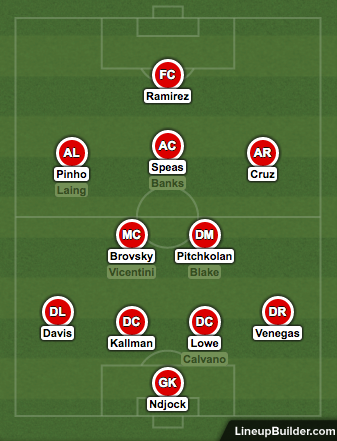
Cruz will most often start inside, towards the center of the field to give Kevin Venegas room to run forward. If Venegas makes that run, Cruz will look to make a complementary run to support the attack while also being ready to cover Venegas’ defensive duties if he gets caught in transition.
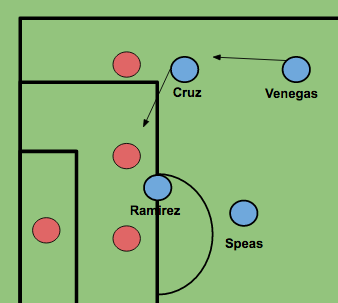
With Venegas forward, it creates mismatches. The typical back four NASL teams employ uses a zonal marking scheme. That means that each player is responsible for an area of the pitch in relation to the other three in the back line. By tucking inside, Cruz is able to force the opponent’s left full back and left center back to make a choice.
Whoever moves to guard him creates more space for either Venegas on the outside or Christian Ramirez on the inside to make an attacking run. When playing off of Venegas’ runs, it’s more about Cruz’s off-the-ball movement to create space and opportunities.
Running the Channels
When Venegas stays back, Cruz has the option to run the channels or get wide. Running the channels, in soccer parlance, is when a player makes runs in between two of the defenders, forcing them to make a decision about who will cover him.
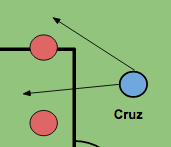
Cruz will also make runs wide, creating space for the defense or midfield to clear the ball and give the defense breathing room. It’s hard, physical work, as can be seen on this shot on goal early in the 5-1 win over Carolina.
Secondary Partnerships
The right winger for Minnesota also has to be an adept passer. Cruz will look to the number ten, who is usually Ben Speas (but also has been Bernardo Anõr and J.C. Banks), to receive the ball and then play it out wide to Venegas or another Minnesota player.
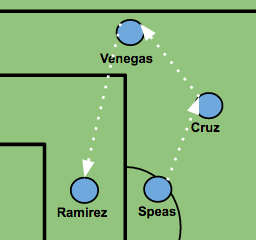
Minnesota often will face defenses who sit back. This means that the defense will pack eight or more players behind the ball, usually in two rows of four, cutting out passing lanes and space for Minnesota to move and attack. By passing the ball quickly out from the middle of the field to the sideline, Minnesota is forcing their opponents to quickly change their defensive shape. Hopefully, this creates space and mismatches for Minnesota to exploit.
The Left Winger
Cruz on the right is a connector, a player who works with the other players around him to create space and chances for the team. It’s not always the most exciting role on the field and is not a style of play Cruz has played before, but it is a huge part of the offensive success of Speas, Ramirez, and Venegas.
On the left is a more traditional winger in Pinho, even though he is a converted striker. With Justin Davis playing more conservatively this year and joining the attack only at opportune moments like counter attacks, Pinho operates mainly from the touchline. Looking at an average position map from Carolina, you can see that Pinho is out wide much more than Cruz.
As Minnesota is building their attack, Pinho has his heels on the touchline, spreading the defense wide. He is ready to receive the ball to stretch the defense and beat his defender one-on-one. He will make long runs up the sideline to chase down long balls from the back line or defensive midfield.
This position out wide means that Pinho will be also making late runs into the box. This creates an option for Ramirez or Speas when they have the ball in the box. A great example of this type of play was the third goal against Carolina.
While neither player is playing their true position, each is adding to the success of the team.
I hope you enjoyed this feature. If you have a position or tactic you would like expounded upon in an upcoming feature, share it in the comments below!
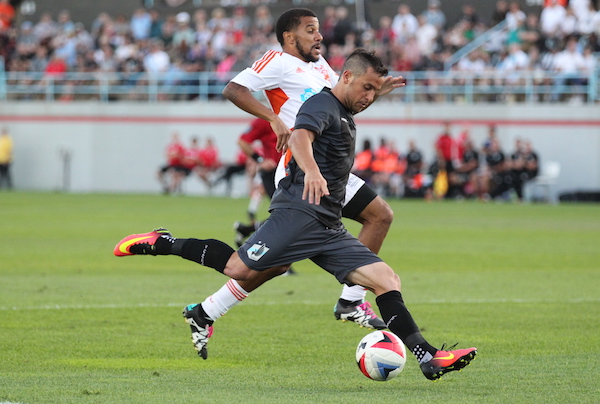
Leave a Reply